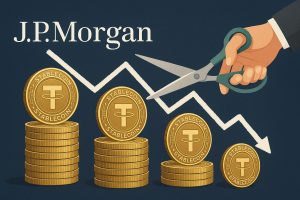Introduction
In a significant move that underlines the deepening interest of institutional players in digital assets, Tower Research Capital has amplified its cryptocurrency trading operations via its specialized crypto arm, Limestone. As digital markets rebound from a challenging 2024, this expansion marks a calculated shift in strategy from one of the world’s most renowned high-frequency trading (HFT) firms. Tower Research’s deeper integration into the crypto trading ecosystem reflects more than just a market opportunity—it underscores the transformation of digital assets into mainstream institutional portfolios.
This development comes at a time when the crypto industry is experiencing renewed optimism. Following a prolonged bear cycle and regulatory tightening in multiple jurisdictions, early signs of stabilization and institutional re-entry are becoming evident. Tower Research’s expansion through Limestone is not merely opportunistic—it is a forward-looking investment in the infrastructure and capabilities that are likely to define the next generation of financial markets.
Tower Research: From Quant Trading To Crypto Innovator
Founded in 1998, Tower Research Capital built its legacy on algorithmic trading and high-frequency strategies across global financial markets. The firm has long been associated with cutting-edge quantitative models, data science applications, and sophisticated technological infrastructures. As traditional markets became increasingly competitive and saturated, Tower began exploring emerging asset classes, with cryptocurrency standing out as a natural extension of its HFT capabilities.
The move into crypto, initially cautious, was accelerated in response to the explosion of retail interest and decentralized finance (DeFi) developments in the early 2020s. Through its crypto-specific division Limestone, Tower began quietly deploying capital into market-making and liquidity provisioning strategies across centralized exchanges and select DeFi protocols.
The recent decision to scale up Limestone’s activities marks a bold evolution in this strategy, aligning with broader institutional trends and technological innovations reshaping digital finance.
The Role Of Limestone: Tower’s Crypto Engine
Limestone is more than just an experimental arm of Tower Research—it represents the firm’s calculated long-term bet on the viability and profitability of the digital asset ecosystem. Focused exclusively on cryptocurrencies and blockchain-based financial instruments, Limestone leverages Tower’s core strengths: quantitative analysis, ultra-low-latency infrastructure, and predictive modeling.
According to insights from the Cryptonews report dated May 5, 2025, Limestone’s expanded role involves:
- Deploying proprietary algorithms for crypto market-making.
- Providing liquidity to emerging exchanges and institutional-grade trading platforms.
- Engaging with derivatives markets, including perpetual swaps and crypto options.
- Testing execution models on decentralized exchanges and cross-chain protocols.
This is not a superficial commitment. Sources familiar with the firm’s strategy note that internal resource allocation to Limestone has increased significantly, with dedicated engineering, trading, and research teams working exclusively on crypto market strategies.
The Market Context: Crypto’s 2025 Rebound
The backdrop for this expansion is a recovering crypto market. After experiencing volatility in 2024—marked by exchange bankruptcies, regulatory pressure in the U.S., and waning retail interest—the first half of 2025 has shown clear signs of stabilization and recovery.
Bitcoin has rebounded above $50,000, aided by ETF inflows and increasing adoption as a macro hedge. Ethereum continues to benefit from post-merge upgrades and Layer 2 scaling progress. More broadly, the sentiment across institutional desks has shifted from cautious observation to active engagement.
Institutional flows into digital assets have increased, fueled by:
- Improved custody solutions and clearer regulatory frameworks.
- Growth of tokenized assets and real-world asset (RWA) platforms.
- Maturation of trading infrastructure, including execution management systems (EMS) tailored for crypto.
- Integration of decentralized finance into traditional financial workflows.
Tower Research’s decision to scale up now, rather than in the hype of 2021 or the lows of 2023, speaks to its contrarian yet analytical strategy—buying in during recovery phases to capture outsized returns as the cycle matures.
Institutional Signal: What Tower’s Move Really Means?
The importance of Tower Research’s expansion lies not only in the capital being deployed but in the signal it sends to other financial players. In the algorithmic trading and HFT world, Tower is considered a bellwether—a firm known for acting only when the risk-reward ratio meets its stringent criteria.
Limestone’s growth signals several key market observations:
- Volatility has normalized, making markets more predictable for quantitative strategies.
- Liquidity depth is increasing, allowing large-scale trades with minimal slippage.
- Counterparty risk has been better managed, thanks to regulatory improvements and better exchange oversight.
- Data quality from crypto venues has improved, enabling Tower’s predictive models to function with higher accuracy.
Other institutions are likely to interpret Tower’s aggressive positioning as a cue to re-enter or expand their crypto strategies. In past cycles, moves by firms like Tower, Jump Trading, or DRW have often preceded waves of institutional adoption.
Beyond Market-Making: Tower’s Broader Crypto Ambitions
While market-making remains Limestone’s primary focus, insiders suggest the firm is exploring adjacent opportunities:
- Staking infrastructure for proof-of-stake networks.
- Tokenized treasury markets, particularly short-term cash instruments.
- Cross-exchange arbitrage, including DeFi-native liquidity pools.
- Strategic partnerships with custodians, infrastructure providers, and compliance platforms.
The possibility of Limestone expanding into structured products or crypto-native options trading could bring more institutional sophistication to the space. Additionally, Tower is rumored to be testing new models for providing liquidity to DEXs without exposing itself to impermanent loss—leveraging hedging techniques honed in traditional options markets.
Regulatory Comfort And Infrastructure Maturity
A major barrier to institutional adoption in prior years was regulatory uncertainty. In 2025, the picture is improving. The United States has passed a clearer framework for classifying digital assets, with a division of oversight between the SEC and CFTC. Meanwhile, Europe’s Markets in Crypto-Assets (MiCA) regulation has gone into effect, providing a harmonized framework for member states.
For a firm like Tower Research, which operates across jurisdictions, this clarity reduces the legal risk of deploying capital. Equally important is the evolution of the infrastructure that supports crypto trading:
- Prime brokers now offer crypto, reducing counterparty concentration.
- Transaction monitoring and risk systems have become as robust as those in FX or equities.
- Latency across crypto venues is narrowing, enabling more effective arbitrage and predictive strategies.
With these tailwinds, the timing of Tower’s move appears to be deliberate and well-founded.
The Competitive Landscape: HFT In Crypto
Tower Research is not alone in targeting the digital asset space. Other HFT powerhouses such as Jump Crypto, Jane Street, and Wintermute have also made headlines with similar expansions. However, Tower’s focus on a dedicated unit like Limestone suggests a different approach—building from within rather than merely extending existing desks.
This allows for more specialization, quicker innovation cycles, and cultural alignment with crypto’s open-source ethos. Moreover, it enables the firm to pursue opportunities that may be incompatible with its traditional compliance structure—such as participation in DAOs or providing liquidity to permissionless platforms.
Conclusion
Tower Research’s expansion of its crypto division, Limestone, marks more than a business maneuver—it represents an institutional endorsement of the long-term potential of digital assets. In deploying cutting-edge technology and quantitative strategies to this new frontier, Tower is positioning itself not just as a participant but as a future leader in the financial system’s next evolution.
Crypto trading is no longer a fringe pursuit; it is becoming a core asset class, powered by the same engines that run traditional markets—data, speed, and strategy. Tower’s move reminds us that the lines between traditional finance and decentralized innovation are not just blurring—they are merging.
As the crypto ecosystem matures, expect more institutions to follow. And when they do, they will likely be navigating a landscape already mapped out by pioneers like Tower Research.



